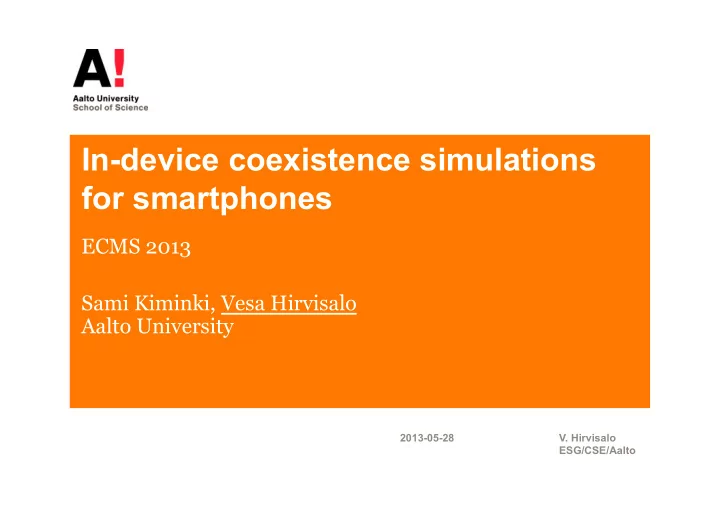

In-device coexistence simulations for smartphones ECMS 2013 Sami Kiminki, Vesa Hirvisalo Aalto University 2013-05-28 V. Hirvisalo ESG/CSE/Aalto
Outline • Cellular radio systems and radio devices – Mobile devices and their subsystems – Radio bands, transmission and radio coexistence • Simulation coexistence – Supporting simulations of complex protocols and hardware – Embedding a simulator into a host language • Some results – Focusing on LTE and WiFi coexistence – Managing radio coexistence opens up new opportunities 2013-05-28 V. Hirvisalo ESG/CSE/Aalto
Cellular networks • Base stations – Forming cells – Hexagonal in principle • The practice is somewhat different • Mobile devices – Connect to base stations • The network – Keeps track who is where • Protocols – Large number of protocols – Several generations of systems: from GSM to LTE • Coexistence – Add other radio systems 2013-05-28 V. Hirvisalo ESG/CSE/Aalto
Mobile devices • Small devices – Battery operated • Energy consumption is important – Include numerous subsystems • Balanced operation needed • Connectivity is essential – Mostly based on radios – Several radios • GSM/LTE, WiFi, Bluetooth, GPS, NFC, .. • Coexistence – Radios interfere with each other • In the air • Inside the devices – Basic ways to avoid • Time domain, frequency domain 2013-05-28 V. Hirvisalo ESG/CSE/Aalto
Radio device • Receivers and transmitters 2013-05-28 V. Hirvisalo ESG/CSE/Aalto
Spectrum usage • Transmitter power exceeds significantly the reception 2013-05-28 V. Hirvisalo ESG/CSE/Aalto
Simulation of coexistence (requirements) • Several different aspects to be covered – On-chip software manages the chip – Discussion between the hardware and protocols • Especially the MAC level of protocols • Physical side not so complex – However, RF chips not trivial • We used a RF-CGRA design – Resource management to be simulated • Protocols managing the coexistence are complex – Must be simulated in detail, but real implementations are huge – Scheduling in time domain – real traffic but with < 1µs details • Real-time – Both synchronous and asynchronous events 2013-05-28 V. Hirvisalo ESG/CSE/Aalto
Simulation of coexistence (our solution) • Embedding the simulator inside a programming language to ensure programmability – Supporting different types of tasks – Basic facilities for radio simulation • Modeling is the challenge – Like a learning project: how to delimit and abstract • The resulting model – Textual representation • Using a programming language (Java based) – Roughly 20000 lines of model description • Validation and verification – Especially for protocol and hardware development 2013-05-28 V. Hirvisalo ESG/CSE/Aalto
Simulator structure • Built on top of a simulation kernel 2013-05-28 V. Hirvisalo ESG/CSE/Aalto
Simulator user interface • Gives detailed information of events – Graphical representation – Using pointer to get more information 2013-05-28 V. Hirvisalo ESG/CSE/Aalto
Simulator user interface • Studying the operation – Finding out the causes for bad behavior – Modifying the protocol(s) results in significant improvements 2013-05-28 V. Hirvisalo ESG/CSE/Aalto
Coexistence benefits • Managed coexistence significantly increases throughput 2013-05-28 V. Hirvisalo ESG/CSE/Aalto
Conclusions • Radio coexistence simulation – Coping with complex protocols and hardware is essential • In-device coexistence – Radios interfere with each other – Basic solution is to have only one radio on • The problem is in predictability • Managing radio coexistence opens up new opportunities – We focused on LTE and WiFi coexistence – U-APSD based mechanism for coexistence • Predicting radio traffic • Reserving time for the competing radio • Research on simulation techniques needed – Large systems mixing different kinds of operation 2013-05-28 V. Hirvisalo ESG/CSE/Aalto
Thank you! 2013-05-28 V. Hirvisalo ESG/CSE/Aalto
Extra slides 2013-05-28 V. Hirvisalo ESG/CSE/Aalto
Simulating WiFi (1) • Beacon 2013-05-28 V. Hirvisalo ESG/CSE/Aalto
Simulating WiFi (2) • UAPSD - trigger 2013-05-28 V. Hirvisalo ESG/CSE/Aalto
Simulating WiFi (3) • Trigger ackn 2013-05-28 V. Hirvisalo ESG/CSE/Aalto
Simulating WiFi (4) • Data 2013-05-28 V. Hirvisalo ESG/CSE/Aalto
Simulating WiFi (5) • First ackn 2013-05-28 V. Hirvisalo ESG/CSE/Aalto
Simulating WiFi (6) • Second data 2013-05-28 V. Hirvisalo ESG/CSE/Aalto
Simulating WiFi (7) • Second ackn 2013-05-28 V. Hirvisalo ESG/CSE/Aalto
Simulating LTE (1) • Scheduling request 2013-05-28 V. Hirvisalo ESG/CSE/Aalto
Simulating LTE (2) • Uplink grant 2013-05-28 V. Hirvisalo ESG/CSE/Aalto
Simulating LTE (3) • First data 2013-05-28 V. Hirvisalo ESG/CSE/Aalto
Simulating LTE (4) • Ackn and next grant 2013-05-28 V. Hirvisalo ESG/CSE/Aalto
Simulating LTE (5) • Rest of data 2013-05-28 V. Hirvisalo ESG/CSE/Aalto
Simulating LTE (6) • Final ackn 2013-05-28 V. Hirvisalo ESG/CSE/Aalto
WiFi development year Speed PHY frequency Bandw. 802.11-1997 1997 2Mbps FH-DSSS 900/2.4MHz 20MHz 802.11b 1999 11Mbps DSSS 2.4MHz 20MHz 802.11a 1999 54Mbps OFDM 5MHz 20MHz 802.11g 2003 54Mbps OFDM 2.4HHz 20MHz 802.11n 2009 150-600 OFDM 2.4/5MHz 20-40 802.11-2012 2012 150-600 OFDM 2.4/5MHz 20-40 802.11ac 2014 300-6700 OFDM 2.4/5MHz 80-160 802.11ad 2014 ~7000 OFDM? 2.4/5/60MHz 2013-05-28 V. Hirvisalo ESG/CSE/Aalto
LTE development • Release 8 – Initial LTE • Release 9 – Networks and services (emergency/location/multicasting/femtocells) but minimal changes to PHY/MAC • Release 10 – (LTE-A, complete): Improved PHY/MAC: carrier aggregation, SU- MIMO • Release 11 – (LTE-A, any time now...): Services, new carrier aggregation combinations, Cooperative multipoint, initial in-device coexistence • Release 12 – (LTE-A evolved, in development): new carrier type (NCT), 3D MIMO, LTE/WiFi integration. . . 2013-05-28 V. Hirvisalo ESG/CSE/Aalto
Recommend
More recommend